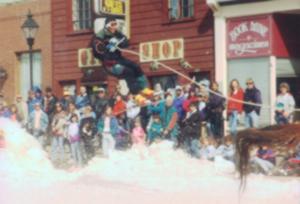Review by Ed Quillen
America – March 2002 – Colorado Central Magazine
America the Beautiful: The Stirring True Story Behind Our Nation’s Favorite Song
by Lynn Sherr
Published in 2001 by Public Affairs
ISBN 1586480855
MOST OF US KNOW, in a vague way at least, that the lyrics to “America the Beautiful” were inspired by a visit to the summit of Pike’s Peak about a century ago.
That’s true, but there’s a lot more to the story, such as the source of the music and the frustrating struggle to make it, rather than “The Star Spangled Banner,” the national anthem. And the story is told here in a thorough but easy-going way, with copious illustrations.
It begins with Katherine Lee Bates, who in 1893 was an English teacher — and poet — at Wellesley College in Massachusetts.
At the time, Colorado College in Colorado Springs imported faculty from prestigious Eastern schools for its short summer term to put its students “in contact with the brightest minds and most progressive spirits of the country.”
Toward the end of the session, the visiting faculty were invited on an excursion to the nearby summit of 14,110-foot Pike’s Peak.
Their stay was short, for two members fainted from the thin air, but it was long enough to make a permanent impression on Bates: “It was then and there, as I was looking out over the sea-like expanse of fertile country spreading away so far under those ample skies, that the opening lines of the hymn floated into my mind.”
That night, she jotted down some verses in her notebook. After returning to Wellesley, she revised and refined them. Her four-stanza poem first appeared in print in a Boston church publication in 1895, and from there it spread from sea to shining sea.
As for the music to go with the lyrics, the tune we use now was written by Samuel Ward, who made a decent living in Newark, N.J., as a piano teacher, church organist, choirmaster, and dealer in pianos, organs, and sheet music.
The tune, which Ward called “Materna,” was originally written for the hymn “Oh, Mother Dear Jerusalem” in 1888. When he died in 1903, he had never heard “America the Beautiful” sung to “Materna.”
These days, the words and music generally emerge at the same time, as with Lennon and McCartney. But a century ago, they were often totally separate. The same tune might be used for a dozen different lyrics, and vice-versa.
Thus the popular poem “America the Beautiful” inspired tunes and was also sung to existing music that fit the rhythmic pattern. Among those was the tune for “Auld Lang Syne.” This sounded so preposterous that I prevailed upon Martha to play it on the piano while I tried singing along with the lyrics to “America the Beautiful.” My singing is terrible, but “America the Beautiful” can fit the New Year’s tune.
Bates never expressed a preference regarding the tune, but over time, “Materna” and “America the Beautiful” became permanently joined.
This was followed by a push to make this the national anthem, since it wasn’t as militaristic and anti-British as its leading competitor, “The Star-Spangled Banner.” (Its lyrics were written by Frances Scott Key after he watched the English fleet shell Ft. McHenry in the Baltimore harbor during the War of 1812, and the tune comes from an old English drinking song called “To Anacreon in Heaven.”)
But Congress designated “The Star-Spangled Banner” in 1931, regardless, and so “America the Beautiful” has no official status — just an affection from millions of Americans, and now, an interesting and informative book.
Plus, when you live here, it adds to the song’s appeal to know that the “purple mountains majesty” which inspired Katherine Lee Bates 109 years ago were our mountains — the Sawatch, Mosquito, and Sangre de Cristo ranges visible from the summit of Pike’s Peak.
— Ed Quillen

